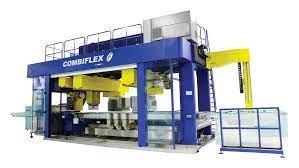Oldcastle BuildingEnvelope (OBE) offers a comprehensive collection of glazing-focused interior and exterior products and services for the commercial building industry. Oldcastle designs, engineers, tests, and manufactures solutions in engineered curtain walls, storefronts and entrances, architectural glass, shower enclosures, glazing hardware, windows, railing, and more. Founded in 1989 with headquarters in Dallas, the company has over 6,700 employees working in 82 locations across North America.

The Situation

In the Spring of 2021 Oldcastle experienced an increase in demand for shower enclosures for use in apartments and hotels. The company soon realized demand outstripped supply. A strategy was created to pivot towards increasing shower enclosure production to keep up with the demand increase.
The challenge was to determine how to increase manufacture of shower doors in response to the growth in demand. In 2021 the Atlanta facility decided to purchase and install Forvet’s Combiflex, a machine that can polish and fabricate a shower door simultaneously. Shortly after production began on the Combiflex it was determined it could only maintain an average of one hundred shower doors per day. Unfortunately, this output rate was still below the customer demand rate.

The Solution
Management at the Atlanta facility decided to use Lean Six Sigma to identify opportunities to increase production on the Combiflex. A goal was set of 175 shower doors per day. Murphy Boales, who had recently completed TMAC’s LSS Black Belt course, was assigned to lead the Lean Six Sigma team. The team, which included representatives from fabrication, production, and cutting, began meeting on a regular basis. They used the DMAIC process and fundamental LSS tools to diagnose the root cause of the problem including value-stream mapping, task time charts and control charts. Soon they identified several quick wins which helped gain buy-in from employees.
During the Improve Phase of the project Murphy challenged the team to think differently about what could be done to increase capacity. Ultimately the team implemented the following solutions:
- Re-evaluated the Maintenance Schedule and Workload
- Assigned Some Maintenance Responsibilities to Operators
- Established a KANBAN loop to create a Just-In-Time Manufacturing environment
- Empowered Employees by launching Daily Huddles
- Fixed Errors in the Order Entry Process

The Results

After implementing these solutions, the team successfully increased output to an average of two hundred shower doors a day by March 2022 – doubling output! This resulted in a 34% increase in sales, accruing to a 7 million dollar increase annually!
- 34% increase in sales which equates to a 7M dollar increase
- Doubled output of shower doors from 100 to 200 doors per day
- Atlanta location led the process improvement for the entire company
Murphy planned and prepared well and was ready to lead the project. Together, we picked a team that was a great mix of process owners and people outside of the department… They started to uncover issues and problems that we never knew existed and they worked immediately to find solutions to those problems. She showed them what we could accomplish with greater communication and teamwork. She made them believe that all suggestions were valid and should be brought to the team even if they weren’t used in the end. The results have spoken for themselves. Our plant now has the model area and process for the entire company. It is a welcome change to be able to know we now have a path to fundamentally change the way we run our business.
Scott Morris
Operations Manager








